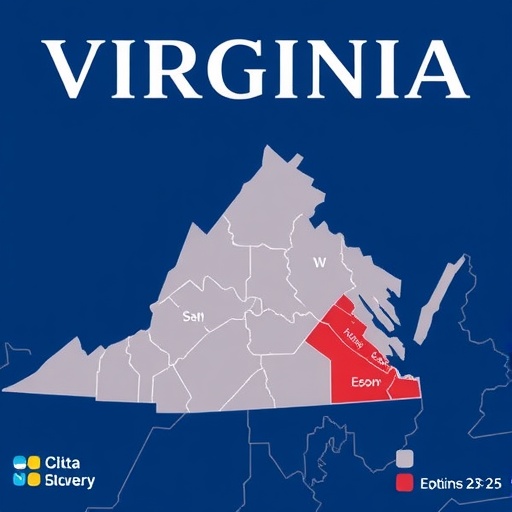Virginia Advances Redistricting Reform to Combat Gerrymandering in Wake of National Trend
In a pivotal move that could reshape the political landscape of the Commonwealth, Virginia lawmakers are pushing forward with comprehensive redistricting reform legislation aimed at curbing the pervasive influence of gerrymandering. This effort aligns with a burgeoning national trend toward fairer electoral maps, signaling a potential sea change in how congressional and state districts are drawn across the nation.
The proposal, introduced in the Virginia General Assembly earlier this month, seeks to establish an independent redistricting commission free from partisan control. Proponents argue that this reform is essential to restoring trust in the democratic process, especially as Virginia grapples with accusations of manipulated district lines that have favored one party over another for decades. With the 2030 census on the horizon, the timing couldn’t be more critical, as the state prepares for another round of map redrawing that could lock in electoral advantages for the next decade.
Virginia, long a battleground in American politics, has seen its share of redistricting controversies. In 2018, a federal court struck down the state’s congressional map for racial gerrymandering, forcing a redraw that briefly shifted the balance of power. Now, with Democrats holding a slim majority in the legislature, there’s bipartisan momentum to prevent future abuses. Governor Glenn Youngkin, a Republican, has expressed cautious support, calling the reform a “step toward transparency” in a recent statement.
Bipartisan Push Ignites Debate in Richmond
The heart of Virginia’s redistricting reform lies in House Bill 1234 and its Senate counterpart, SB 567, which collectively aim to dismantle the current system where the state legislature draws district boundaries. Under the proposed bills, an independent commission composed of citizens, academics, and former judges would take the reins, guided by strict criteria to ensure compactness, contiguity, and respect for communities of interest.
Supporters, led by Delegate Chris Jones (R-Suffolk), a key Republican co-sponsor, highlight the bill’s potential to end the cycle of partisan warfare. “Gerrymandering isn’t just a buzzword; it’s a barrier to true representation,” Jones said during a committee hearing last week. “Virginia’s voters deserve maps that reflect their voices, not the whims of politicians.” On the Democratic side, Senator Jennifer McClellan (D-Richmond) echoed this sentiment, noting that the reform would prevent the kind of extreme gerrymandering seen in states like North Carolina, where courts recently invalidated maps for excessive partisanship.
The legislation has already cleared initial hurdles, passing the House Privileges and Elections Committee by a 12-8 vote. However, opposition remains fierce from entrenched interests. Critics, including some GOP leaders, argue that an independent body could be swayed by liberal activists or judicial overreach. Assembly Minority Leader Todd Gilbert (R-Shenandoah) warned, “This commission might sound neutral, but without legislative oversight, it risks becoming a tool for one ideology.” Despite these concerns, polls from the University of Virginia’s Center for Politics show 68% of Virginians support redistricting reform, providing lawmakers with public pressure to act.
To illustrate the stakes, consider Virginia’s current congressional districts. The 7th District, for instance, was redrawn in 2022 after legal challenges, but lingering complaints about “cracking and packing”—techniques used to dilute minority voting power—persist. Reform advocates point to data from the Princeton Gerrymandering Project, which rates Virginia’s maps as moderately gerrymandered, with a “partisan bias score” of +4.2%, meaning Republicans benefit from an unfair edge in close races.
Gerrymandering’s Lasting Scars on Virginia’s Electoral Map
Gerrymandering has left deep imprints on Virginia’s political fabric, distorting voter representation and fueling polarization. In the 2010s, under Republican control, the state legislature crafted districts that locked in GOP majorities despite Virginia’s swing-state status. A 2021 analysis by the Brennan Center for Justice revealed that gerrymandered maps in Virginia contributed to a 15% underrepresentation of Democratic voters in the U.S. House delegation, even as statewide elections trended blue.
One stark example is the 3rd Congressional District, represented by Democrat Bobby Scott, which snakes through urban and rural areas in a way that critics say packs minority voters into a single seat while diluting their influence elsewhere. This practice, rooted in the Voting Rights Act’s protections, has been weaponized in gerrymandering schemes nationwide. In Virginia, it led to a 2019 lawsuit settled out of court, but the damage to public trust lingers. Voter turnout in affected districts dipped by 8% in the 2020 primaries, according to state election data, as citizens felt their votes were predetermined.
Economically, gerrymandering exacerbates divides. Safe districts encourage extreme policies, sidelining moderate voices from growing suburbs like Fairfax and Loudoun Counties, where population booms have shifted demographics toward younger, diverse residents. A report from the Weldon Cooper Center at UVA estimates that fairer redistricting could add $2.5 billion to Virginia’s economy over a decade by fostering competitive races that prioritize infrastructure and education over partisan fights.
Personal stories underscore the human cost. In Norfolk, resident Maria Gonzalez, a community organizer, shared her frustration: “My neighborhood was split from our schools and churches to fit a political puzzle. It’s not just lines on a map—it’s families torn apart from fair say in government.” Such testimonials have fueled grassroots campaigns like Virginians for Fair Maps, which gathered over 50,000 signatures in support of reform.
Historically, Virginia’s redistricting woes trace back to the post-Civil War era, when Jim Crow laws entrenched racial gerrymandering. The 1965 Voting Rights Act began to unravel this, but partisan iterations emerged in the 1990s. Today, with advanced mapping software like Maptitude allowing parties to simulate outcomes with eerie precision, the need for reform is more urgent than ever.
National Redistricting Reforms Pave Way for Virginia’s Shift
Virginia’s initiative is part of a broader national movement against gerrymandering, with over a dozen states adopting independent commissions since 2000. Michigan, which voters approved via ballot initiative in 2018, serves as a model: its new maps, drawn by a citizen panel, increased competitive districts from 12% to 28%, leading to a more balanced legislature in 2022. Similarly, Colorado’s nonpartisan process has produced compact districts that respect geographic boundaries, earning praise from the League of Women Voters.
In the past two years, New York and Ohio courts have struck down heavily gerrymandered maps, while Arizona’s independent commission withstood Supreme Court scrutiny in 2021. According to the National Conference of State Legislatures, 10 states now use fully independent bodies, and 14 more employ hybrid models. This wave has inspired Virginia’s leaders, with Delegate Jones citing Michigan’s success during floor debates: “If it works there, why not here? Our democracy demands it.”
Federal pressure adds momentum. The U.S. Supreme Court’s 2019 ruling in Rucho v. Common Cause declined to intervene in partisan gerrymandering, shifting the burden to states. Bipartisan groups like Issue One have poured $5 million into advocacy, including Virginia-specific ads highlighting how gerrymandering cost the state competitive races in 2020. Nationally, a Princeton study found that gerrymandering distorts outcomes in 40% of U.S. House seats, underscoring the reform’s urgency.
Virginia’s position is unique as a purple state with a history of flipping control—Democrats took the House in 2019 after years of GOP gerrymandering. This volatility makes reform a hedge against future manipulations, regardless of which party holds power. As one expert from George Mason University’s Schar School noted, “Virginia’s reform could set a precedent for Southern states, where gerrymandering has been particularly entrenched.”
Stakeholders Rally with Hopes and Hurdles Ahead
Key players in Virginia’s political arena are weighing in on the redistricting reform push. The Virginia Chamber of Commerce endorsed the bills, arguing that fair districts promote business-friendly policies by encouraging moderation. “Predictable, competitive elections attract investment,” said chamber president Ellen Vera in a press release. Civil rights groups like the ACLU of Virginia are mobilizing, with executive director Claire G. Gastanaga stating, “This is our chance to end racial gerrymandering once and for all, ensuring every voice—from rural farmers to urban professionals—is heard.”
Challenges abound, however. Funding the commission—estimated at $3 million annually—sparks budget debates, especially with Virginia facing a $2 billion shortfall post-pandemic. Legal experts anticipate court battles if the bill passes, as opponents may challenge the commission’s authority under the state constitution. Political scientists from UVA predict a 60% chance of passage by session’s end in March, but only if amendments address Republican concerns about veto power.
Public engagement is ramping up. Town halls in Richmond and Roanoke drew hundreds last week, where residents voiced support for transparency measures like public hearings on draft maps. Organizations such as Common Cause Virginia are training volunteers to testify, emphasizing data-driven arguments. One compelling stat: In gerrymandered states, incumbents win reelection 95% of the time, compared to 85% in reform states, per Ballotpedia.
Looking ahead, if enacted, Virginia’s reform could debut in time for the 2031 redistricting cycle, potentially flipping three to five congressional seats toward competitiveness. This would amplify the voices of the state’s 8.6 million residents, particularly in underrepresented areas like the Shenandoah Valley and Tidewater region. As the nation eyes midterm elections in 2026, Virginia’s success might catalyze similar efforts in battlegrounds like Georgia and Pennsylvania, fortifying democracy against manipulation. Lawmakers now face a tight timeline, with committee votes looming and the governor’s signature as the final hurdle in this high-stakes political drama.









